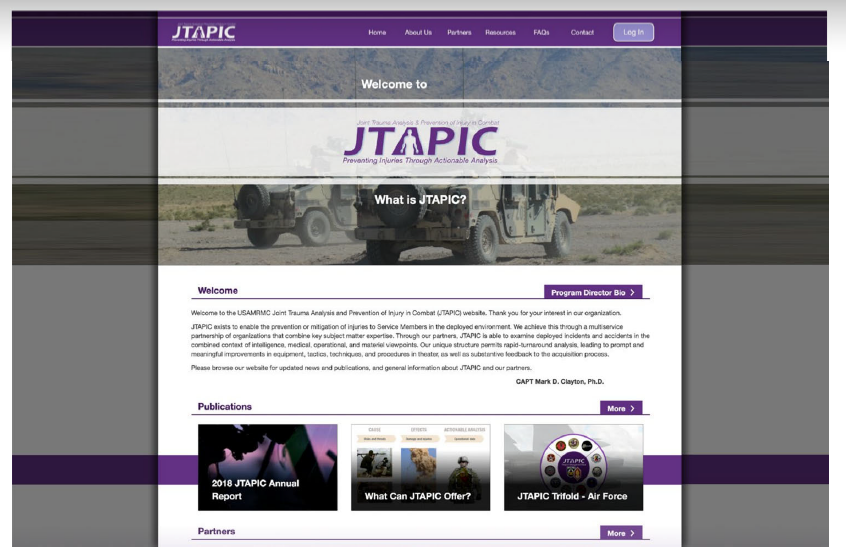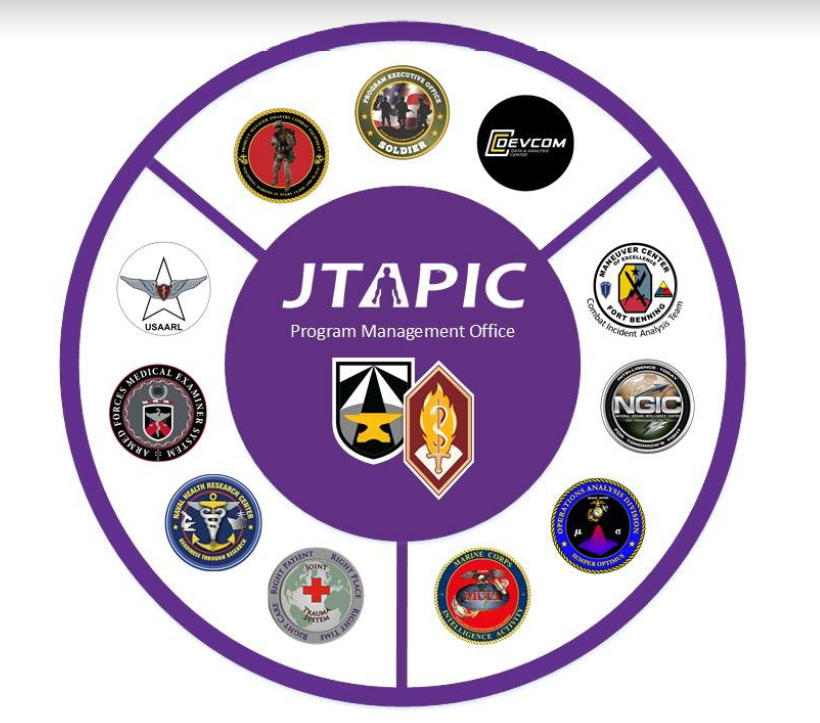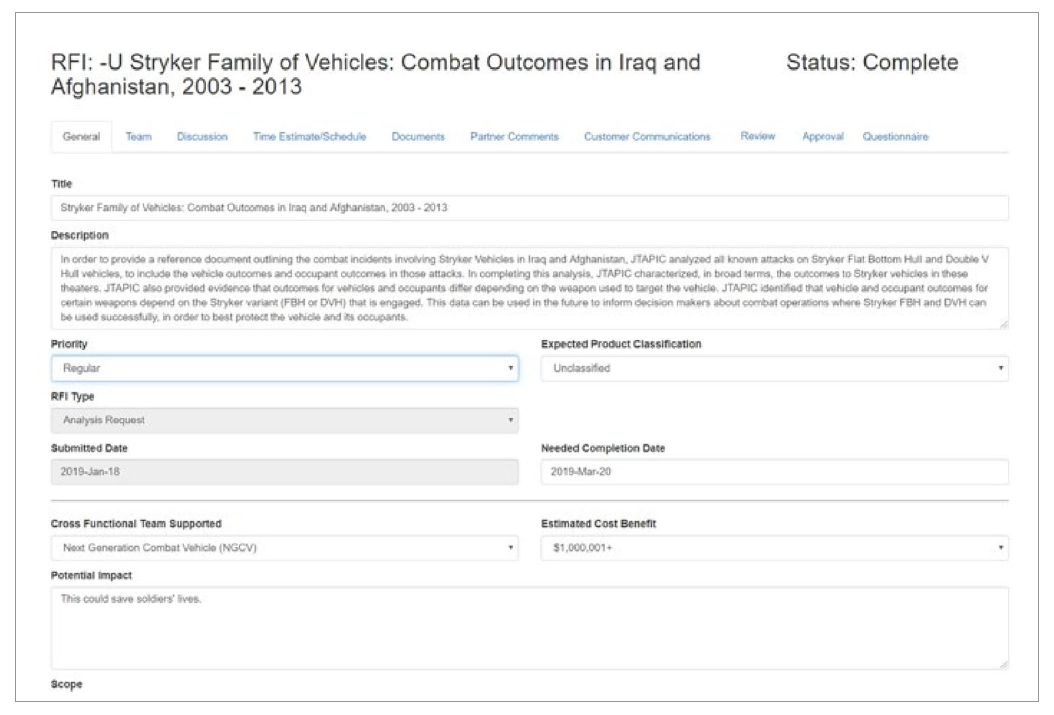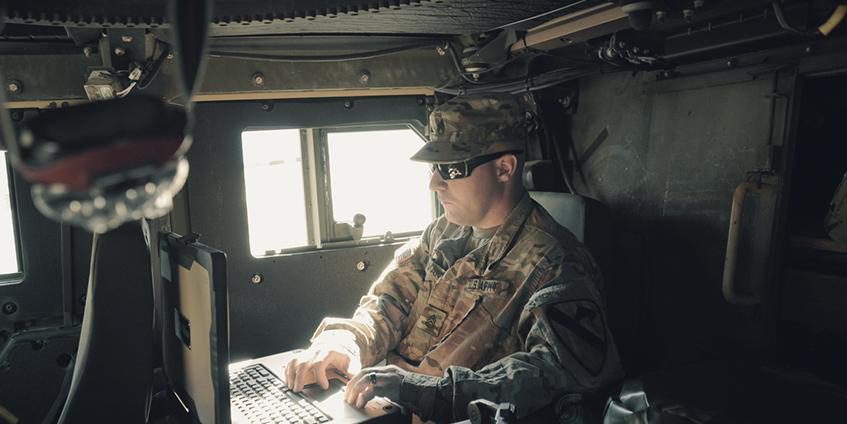INTRODUCTION
The U.S. Army Engineer Research and Development Center (ERDC) is currently developing a new online collaborative system for the Joint Trauma Analysis and Prevention of Injury of Combat (JTAPIC) Program to meet its critical mission goals to support Service members in theater. JTAPIC’s mission is to enable the prevention or mitigation of injuries to Service members in the deployed environment. JTAPIC and its partners examine deployed incidents and accidents in the combined context of intelligence, medical, operational, and materiel viewpoints. By combining these four multidisciplinary areas in the analysis process, JTAPIC provides advancements and information for equipment, tactics, techniques, and procedures in theater and feedback to the acquisition process. For example, “modifications and upgrades have been made to vehicle equipment and protection systems, such as seat design, blast mitigating armor, and fire suppression systems.
Combatant commanders have altered tactics, techniques, and procedures in the field as a result to the incident analyses and near real-time feedback on threats provided by the JTAPIC Program” [1]. This article discusses JTAPIC, past projects, and the new Web-based system currently being developed. Figure 1 is a screenshot of the new JTAPIC public Web site.

BACKGROUND
The National Defense Authorization Act for Fiscal Year 2006, Public Law 109-163 [2], provides that the “Secretary of Defense shall designate an executive agent to be responsible for coordinating and managing the medical research efforts and programs of the Department of Defense (DoD) relating to the prevention, mitigation and treatment of blast injuries.” DoD Directive 6025.21E [3], in compliance with Section 256 of Public Law 109-163, “designates the Secretary of the Army … as the DoD executive agent … for Medical Research for Prevention, Mitigation and Treatment of Blast Injuries” and describes the responsibilities. JTAPIC has supported the executive agent for DoD Directive 6026.21E since 2006.
The JTAPIC charter [4], signed by the Secretary of the Army, designated JTAPIC as a permanent program effective 1 October 2012 to “assist the DoD Executive Agent in fulfilling its designated responsibilities and function related to medical research for the prevention, mitigation, and treatment of blast injuries….The mission of the [JTAPIC] Program is to facilitate the collection, integration, and analysis of injury outcome, materiel performance, and operational and intelligence data to improve the understanding of our vulnerabilities to threats and enable the development of improved protective equipment; vehicular equipment; and tactics, techniques, and procedures that will prevent and/or mitigate combat injuries.”
PARTNERS
JTAPIC, led by the Program Management Office (PMO), is a partnership between DoD intelligence, operational, medical, and materiel development communities that collects, integrates, and analyzes injury and operational data. The materiel partners are PdM Infantry Combat Equipment, Program Manager Soldier Protection and Individual Equipment (PM SPIE), and U.S. Army Combat Capabilities Development Command – Data Analysis Center (CCDCDAC). The operations and intelligence partners are the Combat Incident Analysis Team (CIAT), National Ground Intelligence Center Combat Incident Analysis Division (NGIC/CIAD), Marine Corps Intelligence Agency, and Marine Corps Combat Development Command– Operations Analysis Directorate. The medical partners are the Joint Trauma System (JTS), Naval Health Research Center (NHRC), Armed Forces Medical Examiner System (AFMES), and U.S. Army Aeromedical Research Laboratory (USAARL). Figure 2 shows these partners in JTAPIC’s logo.

After the occurrence of a combat event, personal protective equipment (PPE), ballistic fragmentation evidence, threat assessments, and battle damage assessment of vehicular equipment are conducted and collected, along with operational data. At the same time, casualty (wounded in action [WIA], killed in action [KIA], or died of wounds [DOW]) identification occurs through medical and operational reporting channels. Under strict federal, DoD, and Service privacy acts, guidelines, and procedures, protected health information is linked to classified intelligence and operational reports. JTAPIC gathers information from these disparate sources to link cause (incident operational data and analysis), effect (injury and combat casualty care data and analysis), and mitigation (materiel performance data and forensic equipment analysis) factors to adequately analyze a combat event [5].
Materiel recovery and analysis is a combined effort by PM SPIE, AFMES, and CCDC DAC (formerly the U.S. Army Research Laboratory Survivability/Lethality Analysis Directorate) to provide in-theater collection of damaged PPE (e.g., individual helmets and body armor) from KIA service members, and identifying and analyzing foreign bodies (ballistic fragments) removed from KIA or DOW service members during postmortem examination. PPE returned from theater is analyzed for damage and performance, and retrieved fragment material properties are characterized. Fragment analysis data provides clues to the threat weapons involved in an incident, and modeling by CCDC DAC provides kinetic energy data useful to PPE and armor developers [3]. JTAPIC is pursuing return of ballistic fragmentation and damaged PPE from WIA Service members in concert with the Assistant Secretary of the Army for Acquisition, Logistics, and Technology.
Detailed forensic crosswalks of combat incidents link key information from numerous disparate sources related to a specific combat event. CIAT provides operations and intelligence data; AFMES provides information on KIA service members; NHRC, JTS, and USAARL provide information on WIA; CCDC DAC provides analysis on any fragments collected from the incident and models the event; and PM SPIE provides analysis of the PPE involved in the incident [5].
The JTAPIC partnership provides customers a multidisciplinary analysis to help answer complex questions, such as survivability models and analyses, support vehicle and equipment development, and milestone acquisition decisions, and characterize injuries typical of a given combat scenario. Specific processes for event types, materiel, and personnel and disseminating and analyzing data are standardized.
Anyone with a common access card (CAC) can request analysis or submit a request for information (RFI) to obtain information on areas relating to preventing or mitigating injuries to the Warfighter. These could run the range of combat event injuries to potentially accident-causing injuries. The RFI process results in a variety of analysis products used to fill intelligence gaps and aid in completing combat or accident event analysis.
Ultimately, JTAPIC products often contribute to materiel or nonmateriel solution modifications and improve overall understanding of threat vulnerabilities. JTAPIC products enable the development of improved materiel solutions; PPE; vehicular equipment; and tactics, techniques, and procedures, ultimately to develop better ways to prevent and mitigate injuries to the Warfighter. In the future, as JTAPIC expands its aperture, the intention is to modify processes so other civilian agencies and allies have access to JTAPIC products to strengthen their decision support [5].
PAST PROJECTS
Current Operation Incident Report (COIR)
The COIR is a detailed operational and injury report of recent incidents where U.S. Service members were injured while in contact with enemy forces. Once an event occurs, JTAPIC’s CIAT collects operational/intelligence and casualty information. The information is integrated with any available medical or materiel data points to give a detailed picture of the casualty-causing event within the appropriate operational context. This product provides timely and relevant knowledge to customers and partners who utilize JTAPIC’s analysis approach for decision support and provides combatant commanders near-time, holistic, after-action reporting to improve future mission planning.
Data Support for the Office of the Secretary of Defense
This data-only product provides a limited dataset covering dismounted U.S. military combat casualties incurred from January 2011 through May 2017. The data comes from JTAPIC-integrated databases and provides analyzed data detailing when and where casualties were received, inflicting weapons, engagement ranges, distance from blast devices, and specific injuries incurred, when available. It also provides general casualty demographics data, including branch of service, service component, rank, gender, primary and duty military occupational specialty, and unit of permanent assignment.
U.S. Army Tank Automotive Research and Development Center (TARDEC) Occupant Protection Study
This ongoing multipart analysis product (currently in phase 8 of 9) provides TARDEC with information on accidents (collision, rollover, and collision with rollover) and combat casualties sustained in ground vehicles from 2010 through 2015, with a primary focus on occupant survivability. The findings of these studies will be used by TARDEC in developing an overarching crash and rollover standard to advance training, safety, and survivability for Stryker; mine-resistant, ambush-protected; family of medium tactical vehicles; and high-mobility, multipurpose wheeled vehicle platforms. rollover) and combat casualties sustained in ground vehicles from 2010 through 2015, with a primary focus on occupant survivability. The findings of these studies will be used by TARDEC in developing an overarching crash and rollover standard to advance training, safety, and survivability for Stryker; mine-resistant, ambush-protected; family of medium tactical vehicles; and high-mobility, multipurpose wheeled vehicle platforms.
Blast Injury Prevention Standard Recommendation
The analysis request was for the Blast Injury Research Coordinating Office (BIRCO). The lead partner for the request for information was NHRC, and the participating partners were NGIC/CIAD, CIAT, AFMES, CCDC DAC, and JTS. BIRCO needed to identify and prioritize the development of a Blast Injury Prevention Standards Report (BIPSR) based on real-time injury data. BIRCO was performing a reprioritization of blast injury types remaining in the BIPSR process queue. The analysis product showed the total frequency of combat blast injuries and total frequency of those injured from 1 January 2013 through 31 December 2015. Blast injury was defined. The frequency and proportions for each of the customer specified body regions, body subregions, and injury type were provided.
Improvised Explosive Device (IED) Casualty Trends
The analysis request was for COL Nancy Parson, Director, Patient Care Integration, Office of the Surgeon General, for a briefing to the House Armed Services Committee. The lead partner for the request for information was NGIC/CIAD, and the participating partner was CIAT. The product details how IED casualties and incidents are reported, the number of IED casualties from 2014 to 22 December 2016, and injury trending in IED casualties.
JTAPIC INFORMATION AND COLLABORATION SYSTEM (JINCS) ONLINE SYSTEM
ERDC is developing JINCS, an online system that will facilitate rapid turnaround analyses leading to prompt and meaningful improvements in equipment, tactics, techniques, and procedures in theater and the acquisition process. JINCS will be hosted on the nonclassified internet protocol router (NIPR) and secret internet protocol router (SIPR) networks. The collaborative system will contain three main modules: (1) the RFI tracking and management system, (2) the product library, and (3) the database. JINCS will be available in stages beginning mid fiscal year 2020.
All of the JTAPIC resources, with limitations based on permissions, will be available once a JINCS account is obtained. JINCS accounts are available to DoD employees and contractors with a CAC utilizing the DoD-wide public key infrastructure certificate. Registering for an account is quick, easy, and straightforward. New users should go to the JTAPIC home page and follow the link to “Login” and then “Register for an Account.”
RFI MODULE
The RFI management module provides customers the ability to submit an RFI and track the progress made on their RFI. The RFI management module allows customers, PMO, and partners to track the complete life cycle of an RFI. The RFI management system will include a metrics system to track all tasks and record the time spent on each step of an RFI to facilitate performance improvement. Customers, PMO, and partners can view information on an RFI including progress, current tasks, and any future steps necessary to complete it. Figure 3 is a screenshot of the general screen for a completed RFI.

To submit an RFI, a customer completes the analysis request submission online form in JINCS. After submission, the information will be reviewed by the JTAPIC partnership. A JTAPIC project manager (PjM) will be assigned to the RFI and may follow up with the customer about specific questions or to address obvious limitations.
The RFI will fall into one of the following four processes:
- The request has already been answered from a previous JTAPIC project. Pending approval, the associated product will be released to the customer and justification recorded.
- The request does not fall in the scope of JTAPIC and will be redirected to the appropriate organization, with the reasons for any denial/redirection recorded.
- Parts of a request can be answered while other parts cannot. In this case, the PjM will discuss portions of the request that can be answered and reasons for JTAPIC’s inability to answer other portions of the original request.
- JTAPIC and the partners begin developing and analysis product in response to the RFI.
If the RFI falls within the mission scope of JTAPIC, the JTAPIC partners hold a teleconference with the customer so the customer can communicate to the analysts exactly what information is needed. The analysts can describe the type of data available, type of analysis that can be provided, and expected time for a finished product. Once the teleconference has occurred, the request is processed by JTAPIC partners to identify key tasks and milestones, and a detailed schedule is completed and communicated. The customer can view the progress at any time using the tracking system in JINCS. If any issues arise that occur as part of the analysis that affects the scope or timeline of the request, customers are notified by the PjM or PMO. Upon completion, the customer receives an email with a link to the analysis and/or a briefing to discuss the results and review the analysis product. The product will be uploaded in the appropriate product library and subject to any agreed-upon limitations for release or dissemination.
PRODUCT LIBRARY
The product library is a repository of past JTAPIC products as well as products created by JTAPIC partners submitted for inclusion. Determining if a product can be viewed is based on privacy settings and user role and permissions. The library contains a variety of analyses and answers to questions relating to the JTAPIC mission. The products use a hierarchical tagging system to allow users to find related products in an easy and effective manner. The product library allows users the ability to view information on all public products within the system and download the product (with permission) to their local computers. The product library can be accessed on the left-hand menu in JINCS. Products will be housed on either the SIPR network or the NIPR network, according to classification.
JTAPIC ensures actionable information discovered within the JTAPIC partnership activities is shared as broadly as possible, except where limited by law, policy, or security classification. Those data and analysis products produced are communicated in accordance with DoD Directive 8320.02 [6].
JINCS DATABASE
ERDC is in the process of designing and developing a database system to connect the disparate systems, along with subject matter expertise from the partnership for intelligence, operational, medical, and materiel data. JINCS will provide a user interface based on user roles and permissions so users can quickly query the database to perform analysis and view the data in multiple ways to help them better understand it. Analytical tools for data interpretation will be built into the interface to protect data and create efficiencies for system users. The database will strictly be housed on the SIPR network.
CONCLUSIONS
The JTAPIC Program has created over 400 analysis products for over 40 different DoD organizations and is currently conducting additional requests for information. Combatant commanders, vehicle program managers, materiel/combat developers, medical researchers, life cycle managers, and senior leaders throughout the DoD have requested analysis from JTAPIC. These products provide the most accurate representation of a given problem set, during a particular time, for a specific operational environment to aid in complex decision support for the DoD. The new online system facilitates JTAPIC and their partnership in their mission to prevent injuries through actionable analysis that gives decision makers the concrete findings they need. The new online system will drive technology and safety for years to come!
REFERENCES
- JTAPIC. FAQs. http://jtapic.amedd.army.mil, accessed September 2019.
- National Defense Authorization Act for Fiscal Year 2006. “Prevention, Mitigation, and Treatment of Blast Injuries.” Section 256, Public Law 109-163, 2006.
- U.S. DoD. “Medical Research for Prevention, Mitigation, and Treatment of Blast Injuries.” Directive 6025.21E, 5 July 2006.
- JTAPIC. “Charter for the Joint Trauma Analysis and Prevention of Injury in Combat Program,” 12 July 2011.
- JTAPIC. “Joint Trauma Analysis and Prevention of Injury in Combat Program Inaugural Report,” August 2018.
- U.S. DoD. “Data Sharing in a Net-Centric Department of Defense.” Directive 8320.02, 23 April 2007.
BIOGRAPHIES
AMY E. W. BEDNAR is a research mathematician in the Computational Analysis Branch, Computational Science and Engineering Division, Information Technology Laboratory (ERDC). She is currently the program manager developing a new online system for JTAPIC. Most recently, she was the project manager for the research program PLANS (Planning Logistics Analysis Network System), which is a logistical route-planning tool that generates low- to high-range fidelity predictions across different transportation modes (land, air, and sea) and environmental effects. Dr. Bednar holds a Ph.D. in mathematics.
LINDSAY LIBERTO is a program analyst with JTAPIC. Caring for severely wounded combat veterans and their families at Walter Reed National Military Medical Center inspired her commitment to injury prevention. She is a certified injury coding specialist. Ms. Liberto holds an M.S. in clinical nursing and an undergraduate degree in kinesiology/biomechanics.


